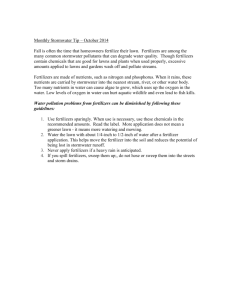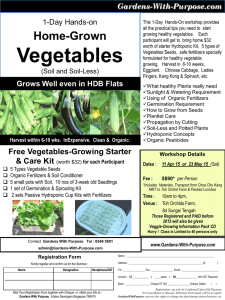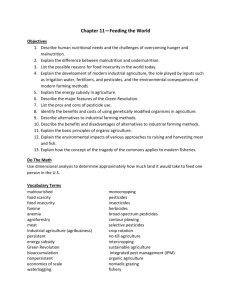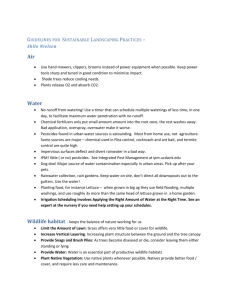What are organic o natural fertilizers
advertisement
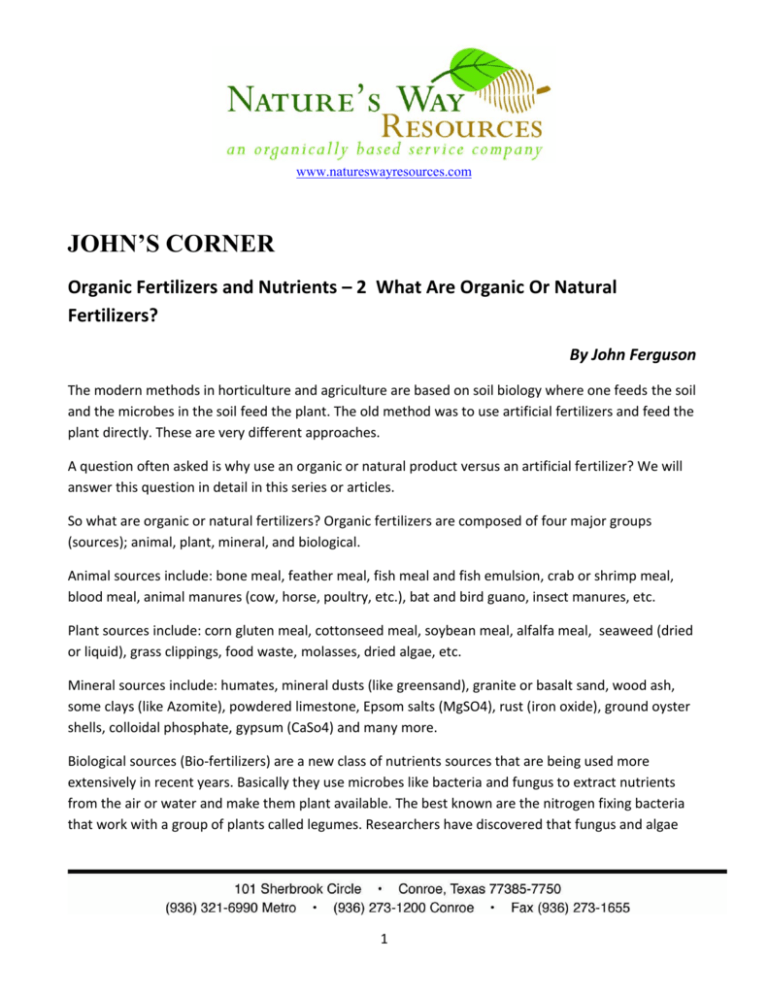
www.natureswayresources.com JOHN’S CORNER Organic Fertilizers and Nutrients – 2 What Are Organic Or Natural Fertilizers? By John Ferguson The modern methods in horticulture and agriculture are based on soil biology where one feeds the soil and the microbes in the soil feed the plant. The old method was to use artificial fertilizers and feed the plant directly. These are very different approaches. A question often asked is why use an organic or natural product versus an artificial fertilizer? We will answer this question in detail in this series or articles. So what are organic or natural fertilizers? Organic fertilizers are composed of four major groups (sources); animal, plant, mineral, and biological. Animal sources include: bone meal, feather meal, fish meal and fish emulsion, crab or shrimp meal, blood meal, animal manures (cow, horse, poultry, etc.), bat and bird guano, insect manures, etc. Plant sources include: corn gluten meal, cottonseed meal, soybean meal, alfalfa meal, seaweed (dried or liquid), grass clippings, food waste, molasses, dried algae, etc. Mineral sources include: humates, mineral dusts (like greensand), granite or basalt sand, wood ash, some clays (like Azomite), powdered limestone, Epsom salts (MgSO4), rust (iron oxide), ground oyster shells, colloidal phosphate, gypsum (CaSo4) and many more. Biological sources (Bio-fertilizers) are a new class of nutrients sources that are being used more extensively in recent years. Basically they use microbes like bacteria and fungus to extract nutrients from the air or water and make them plant available. The best known are the nitrogen fixing bacteria that work with a group of plants called legumes. Researchers have discovered that fungus and algae 1 www.natureswayresources.com can also extract nutrients and make them available to plants. A good reference book (almost 600 pages) on the subject is: Handbook of Microbial Biofertilizers, M.K. Rai (editor), Food Products Press, 2006, ISBN: 13: 978-1-56022-269-9 Many of the commercial products available are blended together from components in the above groups to get a more balanced fertilizer or to address specific issues. A few examples are Microlife (6-24), compost, compost tea, vermi-compost (earthworm castings), blended liquid products (like Garrett Juice, or Microlife's Ocean Harvest and Super seaweed). As you can see many of these are used as soil amendments as well nutrient sources or natural fertilizers. It all depends on what a gardeners goal is, to correct a specific nutrient deficiency or just provide soil and plants nutrients in general. In future articles we will look at each of these in more detail to discover how and when one should use them. SUMMARY: We do not need artificial fertilizers anymore as there are many good organic sources that offer better and lower cost methods of supplying nutrients. These also reduce and even prevent the secondary problems of insects and disease, air and water pollution, erosion, etc. The better nurseries and garden centers now carry a full line of organic fertilizers and they are easily available. PROS: - widely available - inexpensive (total cost less) - naturally slow release - most contain carbon to provide the energy source for the microbes and plants to break them down and use the nutrients - makes plants healthier and more resistant to insects and disease 2 www.natureswayresources.com - helps plants withstand drought, floods, heat or cold better - increases humus content of soil (sequesters carbon) - increases microbial density and diversity - recycles many waste products from other industries - reduces greenhouse gasses (multiple ways) - reduces insect and disease problems CONS: - quality, type, and value varies - not as profitable to sell hence many places do not carry them - some have short lived odors - may attract animals - a few "snake oil" products still around (less than in artificial products). 3



